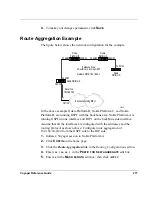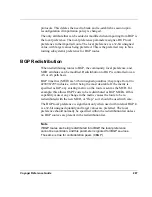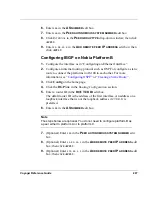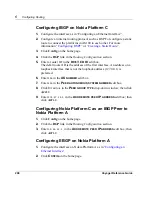
Voyager Reference Guide
283
BGP implementations expect external peers to be directly attached to a shared
subnet and expect those peers to advertise next hops that are host addresses on
that subnet. This constraint is relaxed when the multihop option is enabled in
the BGP peer template during configuration.
Type internal groups determine the immediate next hops for routes by using
the next hop received with a route from a peer as a forwarding address and
uses this to look up an immediate next hop in an IGP’s routes. Such groups
support distant peers, but they need to be informed of the IGP whose routes
they are using to determine immediate next hops.
Where possible, for internal BGP group types, a single outgoing message is
built for all group peers based on the common policy. A copy of the message
is sent to every peer in the group, with appropriate adjustments to the next hop
field to each peer. This minimizes the computational load of running large
numbers of peers in these types of groups.
BGP Path Attributes
A path attribute is a list of AS numbers that a route has traversed in order to
reach a destination. BGP uses path attributes to provide more information
about each route and to help prevent routing loops in an arbitrary topology.
Path attributes may also be used to determine administrative preferences.
BGP collapses routes with similar path attributes into a single update for
advertisement. Routes that are received in a single update are readvertised in a
single update. The churn caused by the loss of a neighbor is minimized, and
the initial advertisement sent during peer establishment is maximally
compressed.
BGP does not read information formed by the kernel message by message.
Instead, it fills the input buffer. BGP processes all complete messages in the
buffer before reading again. BGP also performs multiple reads to clear all
incoming data queued on the socket.
Summary of Contents for Network Voyager
Page 1: ...Voyager Reference Guide Part No N450820002 Rev A Published December 2003 ...
Page 4: ...4 Voyager Reference Guide ...
Page 30: ...2 How to Use Voyager 30 Voyager Reference Guide ...
Page 32: ...3 Command Line Utility Files 32 Voyager Reference Guide ...
Page 220: ...5 Configuring Interfaces 220 Voyager Reference Guide ...
Page 446: ...7 Configuring Traffic Management 448 Voyager Reference Guide ...
Page 618: ...10 Configuring Security and Access 620 Voyager Reference Guide ...
Page 668: ...14 Configuring IPv6 670 Voyager Reference Guide ...
Page 672: ...15 IPSO Process Management 674 Voyager Reference Guide ...
Page 700: ...Index 702 Voyager Reference Guide ...
















































